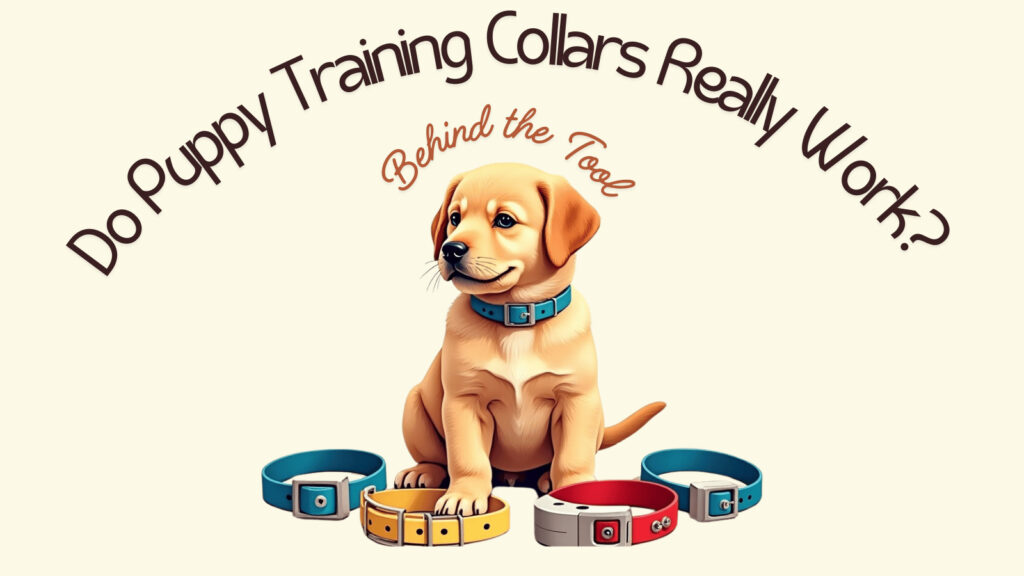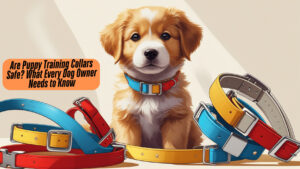Is your new puppy pulling like crazy on the leash? Are walks more of a wrestling match than a relaxing stroll? Maybe you’ve wondered if a training collar could be the answer. Puppy training collars can be pretty controversial. We’ll take a close look at whether they actually work.
This article gives you an unbiased view. You will learn about different types of collars. Also, you will learn how to use them safely and well.
Understanding Puppy Training Collars
What exactly is a “puppy training collar”? It’s not just any collar. It’s a tool made to help train your dog. Let’s explore the options.
What are Puppy Training Collars?
Many types of puppy training collars exist. These include flat collars, Martingale collars, and harnesses. There are also head halters, e-collars, prong collars, and spray collars. Each type works a little differently.
- Flat collars are basic. They attach to a leash.
- Martingale collars tighten slightly when a dog pulls.
- Harnesses go around the dog’s body.
- Head halters guide the dog’s head.
- E-collars use electronic stimulation.
- Prong collars have metal prongs that pinch.
- Spray collars spray a liquid.
Each collar should work by giving the dog feedback. The goal is to discourage unwanted behaviors.
The Science of Positive Reinforcement vs. Aversive Training

Dog training usually falls into two camps. There’s positive reinforcement and aversive training. Positive reinforcement rewards good behavior. Aversive training uses unpleasant stimuli to stop bad behavior.
Flat collars and harnesses support positive methods. Prong collars and e-collars lean towards aversive techniques. It’s important to think about which style fits your values.
The Pros and Cons of Using Training Collars on Puppies
Training collars come with good and bad points. It’s important to weigh them carefully.
Potential Benefits: Improved Leash Manners and Recall
Training collars can help with leash manners. They also might improve recall. This is especially true in distracting places. For example, a head halter can stop pulling. An e-collar might help with off-leash recall.
One puppy, Max, used to bolt after squirrels. His owner used a head halter. Now, Max walks nicely on a leash.
Potential Risks: Physical and Psychological Harm
Improper use can cause harm. Collars might cause injury, fear, or anxiety. A prong collar can hurt if it’s too tight. An e-collar could scare a puppy.
You want to make positive connections. You don’t want the puppy to associate walks with something bad.
Different Types of Puppy Training Collars: A Detailed Look

Let’s dive deeper into each type of collar. This will help you make a smart choice.
Flat Collars and Harnesses: The Gentle Approach
Flat collars hold ID tags. Harnesses are good for leash walking. They don’t put pressure on the neck.
Both are great for puppies. Use them with positive reinforcement. Reward your puppy for walking nicely.
Martingale Collars: Limited Slip for Safety
Martingale collars are also called “limited slip” collars. They tighten a bit when a dog pulls. But they don’t choke the dog. These are safer than choke chains.
These are good for breeds with slender heads, such as Greyhounds. You might also use them during training sessions.
Head Halters: Gentle Guidance and Control
Head halters go around the dog’s muzzle. They give you gentle control. They guide the dog’s head. This makes it hard to pull.
Introduce it slowly. Use treats. Make it a good experience.
Electronic Collars (E-Collars): Remote Training
E-collars use remote control. They send electronic stimulation. Levels vary. It’s important to use them right.
Some experts say e-collars can be effective. Others have big concerns. If you use one, get help from a pro.
Prong Collars: Controversial Correction
Prong collars have metal prongs. These pinch the dog’s neck. They can be misused easily.
Most experts suggest avoiding them. Other options are safer and kinder.
Spray Collars: Distraction Techniques
Spray collars use a spray to distract. Some use citronella. Others use air.
These might work for some behaviors. But some dogs don’t care about the spray. Also, some dogs might get scared.
Safe and Effective Use: Best Practices for Training Collars

If you use a training collar, be responsible. Follow these tips.
Consulting with a Certified Dog Trainer
A trainer can guide you. They can show you how to use a collar safely. Find one with good credentials.
Look for certifications from well-known organizations. A good trainer understands dog behavior.
Proper Fit and Adjustment
A collar should fit well. It shouldn’t be too tight or too loose. You should be able to fit two fingers under it.
Check the fit often. Puppies grow fast.
Gradual Introduction and Positive Reinforcement
Introduce the collar slowly. Let your puppy sniff it. Give treats. Make it fun.
Pair the collar with good things. This creates positive feelings.
Monitoring Your Puppy’s Behavior and Adjusting Accordingly
Watch your puppy closely. Look for signs of stress. These signs might be:
- Lip licking
- Yawning
- Panting
- Tucked tail
If you see these, stop. Try something else.
Alternatives to Puppy Training Collars

Not sure about training collars? Other ways exist.
Positive Reinforcement Training: Treats, Praise, and Play
Reward good behavior. Use treats, praise, and play. This works well for most puppies.
For example, reward your puppy for sitting. Use a tasty treat and lots of praise.
Clicker Training: A Precise Communication Tool
A clicker makes a distinct sound. Pair the click with a reward. The dog learns that the click means something good.
Clicker training is clear. The puppy quickly learns what you want.
Management Techniques: Preventing Problem Behaviors
Stop problems before they start. Use gates and crates. Remove tempting items.
For example, put away shoes if your puppy chews them.
Conclusion
So, do puppy training collars really work? The answer is a resounding yes—when used correctly. A best puppy training collar can be a game-changer for teaching obedience, correcting unwanted behaviors, and ensuring your puppy’s safety. By choosing the right collar, using it responsibly, and pairing it with positive reinforcement, you can make collar training a puppy a positive and rewarding experience for both you and your furry friend.





4 Responses
qmygm6
I have learn a few excellent stuff here. Certainly worth bookmarking for revisiting. I wonder how a lot attempt you set to make the sort of magnificent informative web site.
F*ckin’ awesome things here. I am very satisfied to see your article. Thank you so much and i am looking forward to contact you. Will you please drop me a mail?
Magnificent site. A lot of useful information here. I am sending it to a few friends ans also sharing in delicious. And certainly, thanks for your effort!